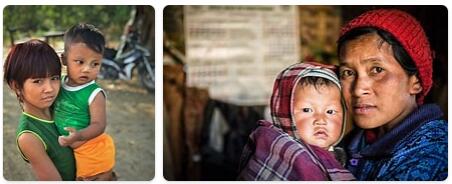There are inscriptions from the 6th century BCE indicating that advanced civilizations existed early in the country. However, making the constant migration of peoples from north to south and from the mountains to the coast as well as their mix and matches, it is difficult to form a picture of the relationship before the 11th century CE At that time defeated the Burmese Hmong people in the south and kadu in north, and created the Kingdom of Pagan.
The following two centuries were a true “golden age” for Burmese thinking and architecture. But Mongol groups attacked from the north with the support of the great Khan of Beijing. The Mongols invasions culminated in 1283 with the fall of the Pagan Empire and continued until 1301. During this invasion, Marco Polo arrived in the country. He was in the service of Kublai Khan and is believed to be the first European to enter Burmese soil.
| Land area | 676,578 km² |
| Total population | 56,590,071 |
| Population density (per km²) | 83.6 |
| Capital | Naypyidaw |
| Official language | Burmese |
| Income per capita | 6,300 USD |
| Currency | Kyat |
| ISO 3166 code | MM |
| Internet TLD | .mm |
| License plate | MYA |
| Telephone code | +95 |
| Time zone UTC | + 06:30 |
| Geographic coordinates | 22 00 N, 98 00 O |
Burma remained divided into small states based on ethnic differences until the 16th century, when the local kings of Toungoo again managed to unite the country. On the 2nd of these rulers, Bayinnaung extended its power to present-day Laos and Thailand. Under him the land reached its greatest extent and its greatest splendor.
But the wastefulness of the state undermined agriculture and the economy and led to an extensive emigration of peasants to the surrounding lands. The dissolution process was further enhanced by the presence of European traders and their rivalry.
In 1740 it was once again a king from Toungoo who restored the country’s unity with the support of the British, but as his descendants continued the national reconstruction project it came into conflict with British interests in Assam (India), and the former European ally turned now against the Burmese. Three major wars took place in the 19th century between Burma and England – in 1820-26, 1852-53 and 1885-86. During the last war, King Thibaw was captured and Burma placed under the English Viceroy of India.
In the 1930s, several nationalist movements emerged: one led by Buddhist monk U Ottama, inspired by Gandhi ; Saya San’s attempt to reinstate the monarchy; and finally, the movements that originated from the University of Rangoon and which tried to combine Buddhism with Marxism. In 1936, a student strike led by Aung San developed into a national protest against the British.
According to thesciencetutor, the anti-colonial movement was not just the expression of the elite in the cities. The collapse of the international rice market in 1930 and the high taxes sent thousands of farmers into debt and ruin at the hands of the British banks and the Indian money lenders. Dissatisfaction turned into xenophobia and popular uprisings in 1938 and 1939.

At the outbreak of World War II, a group of anti-colonial people – known as the “30 comrades” – formed in Bangkok, Burma’s Army of Independence (BIA). It fought with the Japanese against the British and together they captured the capital on March 7, 1943. The ethnic minority people Karen, Kachin and Chin organized the support of Great Britain guerrillas fighting the BIA and the Japanese.